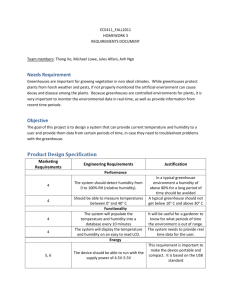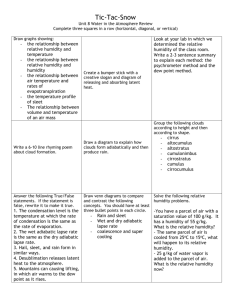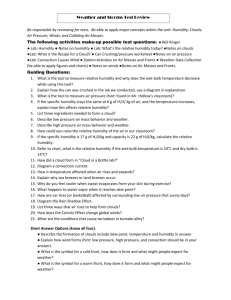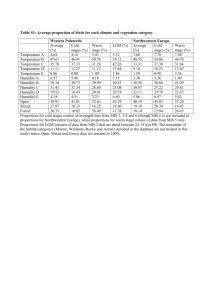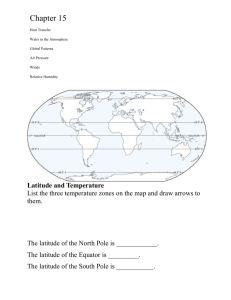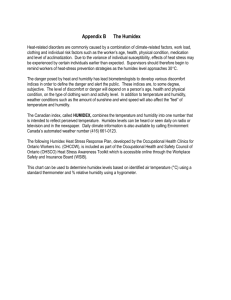Author template for journal articles
advertisement
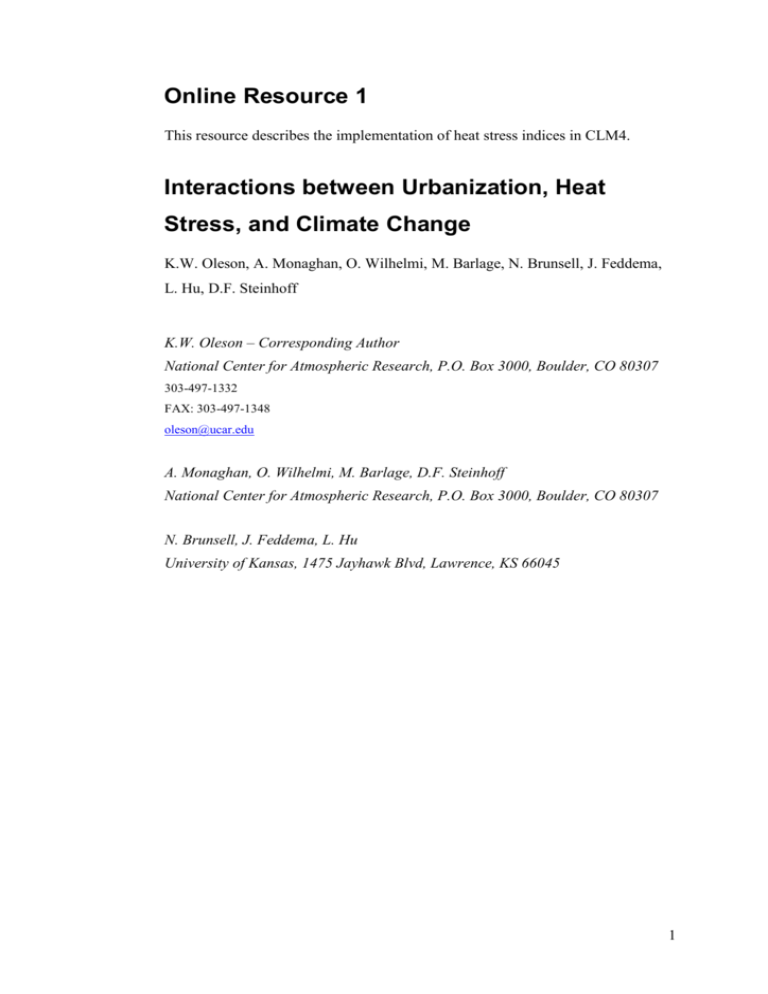
Online Resource 1 This resource describes the implementation of heat stress indices in CLM4. Interactions between Urbanization, Heat Stress, and Climate Change K.W. Oleson, A. Monaghan, O. Wilhelmi, M. Barlage, N. Brunsell, J. Feddema, L. Hu, D.F. Steinhoff K.W. Oleson – Corresponding Author National Center for Atmospheric Research, P.O. Box 3000, Boulder, CO 80307 303-497-1332 FAX: 303-497-1348 oleson@ucar.edu A. Monaghan, O. Wilhelmi, M. Barlage, D.F. Steinhoff National Center for Atmospheric Research, P.O. Box 3000, Boulder, CO 80307 N. Brunsell, J. Feddema, L. Hu University of Kansas, 1475 Jayhawk Blvd, Lawrence, KS 66045 1 Five commonly used heat stress indices are implemented directly in the model and are calculated at each time step. These are the National Weather Service (NWS) Heat Index (HI; Rothfusz 1990), Apparent Temperature (AT; Steadman 1994), Simplified Wet Bulb Globe Temperature (SWBGT; Willett and Sherwood 2012), Humidex (Masterson and Richardson 1979), and Discomfort Index (DI; Epstein and Moran 2006). The HI (°F) is determined from multiple regression analysis by Rothfusz (1990) on data from Steadman (1979) HI C1 C2Ta C3 Rh C4TaRh C5Ta 2 C6 Rh 2 C7Ta 2 Rh C8TaRh2 C9Ta 2 Rh2 (A.1) where C1 42.379 , C2 2.04901523 , C3 10.14333127 , C4 0.22475541 , C5 6.83783 103 , C6 5.481717 102 , C7 1.22874 104 , C8 8.5282 104 , C9 1.99 106 , Ta is air temperature (°F), and Rh is relative humidity (%). The AT (°C) is taken from equation (22) of Steadman (1994) AT Ta 3.30e 0.70u10 4.0 (A.2) where Ta is air temperature (°C), e is water vapor pressure (kPa) and u10 is 10-m height wind speed (m s-1). Water vapor pressure is calculated following CLMU (Oleson et al. 2010a) from saturated water vapor pressure determined by the eighth-order polynomial fits of Flatau et al. (1992). The SWBGT (°C) is taken from Table I of Willett and Sherwood (2012) SWBGT 0.567Ta 0.393e 3.94 (A.3) where Ta is air temperature (°C) and e is water vapor pressure (hPa). The Humidex is Humidex Ta 5 9 e 10 (A.4) where Ta is air temperature (°C) and e is water vapor pressure (hPa). The DI is taken from equation (4) of Epstein and Moran (2006) and is a unitless index DI 0.5Tw 0.5Ta (A.5) where Tw is wet-bulb temperature (°C) and Ta is air temperature (°C). Wet-bulb temperature is from equation (1) of Stull (2011) 2 Tw Ta atan 0.151977 Rh 8.313659 atan Ta Rh atan Rh 1.676331 12 (A.6) 0.00391838Rh3 2 atan 0.023101Rh 4.686035 where Ta is air temperature (°C) and Rh is relative humidity (%). This equation is valid for standard sea level pressure of 101.325 kPa, relative humidity between 5% and 99% and for air temperatures between -20°C and 50°C, except for cases having both low humidity and cold temperature (Stull 2011). In the simulations here, the temperature limits are never exceeded and the humidity limits are rarely exceeded. However, for completeness and since the model cannot process discontinuous data these limits are applied as follows. If Ta is greater than 50°C, it is reset to 50°C. Relative humidity greater than 99% is set to 99% and below 5% is set to 5%. To account for the combination of low humidity and cold temperatures, a minimum relative humidity is calculated based on the equation of the line describing these limits in Fig. 2 of Stull (2011). If humidity is below this limit or if Ta is less than -20°C, the Tw is set to Ta . Fig. S1 shows how the heat indices vary with temperature, humidity, and wind speed. The indices are implemented for rural and urban surfaces in the model. The rural calculations use the 2-m height model diagnostics for air temperature and humidity and the diagnostic 10-m wind speed (Oleson et al. 2010b). The urban calculations use CLMU’s air temperature and humidity in the UCL, and the diagnostic 10-m wind speed (Oleson et al. 2010a). REFERENCES Flatau PJ, Walko RL, Cotton WR (1992) Polynomial fits to saturation vapor pressure. J Appl Meteor 31:1507-1513 Epstein Y, Moran DS (2006) Thermal comfort and the heat stress indices. Ind. Health 44:388-398. Masterson J, Richardson F (1979) Humidex, a method of quantifying human discomfort due to excessive heat and humidity. CLI 1-79, Environment Canada, Atmospheric Environment Service, Downsview, Ontario. Oleson KW, Bonan GB, Feddema JJ, Vertenstein M, Kluzek E (2010a) Technical description of an urban parameterization for the Community Land Model (CLMU). NCAR Tech Note NCAR/TN-480+STR, 169 pp. http://www.cesm.ucar.edu/models/cesm1.0/clm/CLMU_Tech_Note.pdf Oleson KW, Lawrence DM, Bonan GB, et al. (2010b) Technical description of version 4.0 of the Community Land Model (CLM). NCAR Technical Note NCAR/TN-478+STR, 257 pp. http://www.cesm.ucar.edu/models/cesm1.0/clm/CLM_Tech_Note.pdf 3 Rothfusz LP (1990) The Heat Index “Equation” (or, more than you ever wanted to know about heat index. Scientific Services Division, NWS Southern Region Headquarters, Fort Worth, TX Steadman RG (1979) The assessment of sultriness. Part I: A temperature-humidity index based on human physiology and clothing science. J Appl Meteor 18:861-973 Steadman RG (1994) Norms of apparent temperature in Australia. Aust Met Mag 43:1-16 Stull R (2011) Wet-bulb temperature from relative humidity and air temperature. J Appl Meterol Climatol 50:2267-2269 Willett KM, Sherwood S (2012) Exceedance of heat index thresholds for 15 regions under a warming climate using the wet-bulb globe temperature. Int J Climatol 32:161-177 4 Fig. S1 Isopleths of heat indices as a function of temperature and relative humidity. All indices have units of °C except the Discomfort Index which is a unitless index. 5


